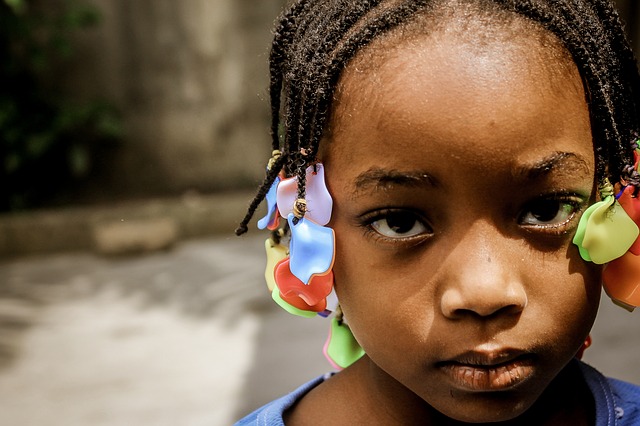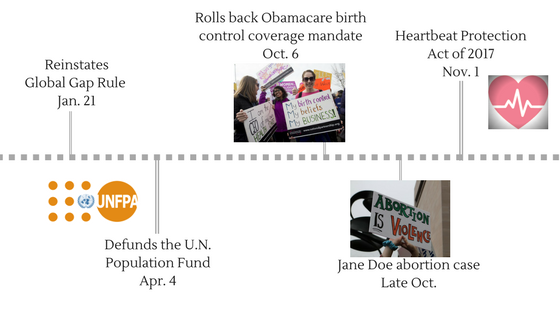A lot has occurred in regards to reproductive rights during Trump’s first year in office. 2017 was filled with legislation and decisions by the Trump administration about women’s rights, and spoiler alert: they weren’t positive developments. And not only were the Trump administration’s decisions harmful for women of the United States, they affected women worldwide.
On his very first full day in office, Trump reinstated what is known as the “Global Gag Rule”. A policy first established by President Ronald Reagan, it prevents any overseas organization from receiving U.S. aid if they provide information about or support abortion services in any way. Enacted in 1984, the Global Gag Rule was later rescinded by President Bill Clinton, reestablished by President George W. Bush in 2001, and rescinded again by President Barack Obama in 2009. Trump’s reinstating of the policy is extremely controversial due to the numerous negative consequences it has for women and families around the world– consequences that aren’t even the result of abortion issues. While it is meant to target abortion providers, in the past, it has affected maternal and child health, contraceptive and HIV services, and even malaria services. Interestingly enough, it has not reduced abortions at all. In fact, the policy led to even more unwanted pregnancies around the world. The Global Gag Rule disproportionately affects poor women and their families, hence the extremely controversial nature of the policy.

In April, Trump and his administration decided to defund the U.N. Population Fund (UNFPA) which deals with family planning, reproductive health, and maternal and child-health services in over 150 countries. Why? The U.S. government claims its policies violate one of the anti-abortion policies of the U.S. The State Department issued a letter to the Senate Foreign Relations Committee to announce that it would no longer fund UNFPA. The letter said the decision was reached because the agency “supports, or participates in the management of, a program of coercive abortion or involuntary sterilization” in China. UNFPA called this claim “erroneous”, saying that “all of its work promotes the human rights of individuals and couples to make their own decisions, free of coercion or discrimination”. The U.S.’ defunding of UNFPA is brutal for the agency, considering that in 2015 the U.S. was its fourth largest donor with $75 million given. This decision will yet again disproportionately affect poor women and their families, crippling their health and family planning services.
In October, Trump made headlines yet again when he rolled back the Obamacare birth control coverage mandate. By allowing virtually any employer to claim a religious or moral objection to the mandate, Trump all but trashed women’s access to contraceptive services. This executive order will affect women across the nation, in staggering numbers. About 55 million women have directly benefited from no-cost birth control, according to an Obama administration report released last year. One study estimated that women saved $1.4 billion on birth control pills in 2013 as a result of the coverage requirement. Trump’s roll back on the mandate is yet another example of his blatant disregard for women’s needs and overall health and is proof that he is very capable of continuing to attack women’s rights.

Earlier this year, Congress also introduced the “Heartbeat Protection Act of 2017”, This bill amends the federal criminal code to make it a crime for a physician to knowingly perform an abortion: (1) without determining whether the fetus has a detectable heartbeat, (2) without informing the mother of the results, or (3) after determining that a fetus has a detectable heartbeat. While it provides an exception for an abortion that is necessary to save the life of the mother or in cases of rape or incest, this bill would still be crippling to women, many of whom don’t even know they’re pregnant before the presence of a heartbeat. This bill would make it so that a physician who performs a prohibited abortion is subject to criminal penalties—a fine, up to five years in prison, or both. While this bill has not been voted on yet, and probably will not pass through Congress, Congress did hold a hearing on the bill on November 1. The more Congress debates a “heartbeat” bill, the more likely other infringements on abortion rights will come to be seen as acceptable compromises.
Lastly, in October, a Jane Doe case made headlines after a 17-year-old girl who fled to the United States from Central America to escape serious physical abuse found out she was pregnant and was prevented from having the abortion she wanted because of the Trump administration. E. Scott Lloyd, the Trump appointee heading the Office of Refugee Resettlement (ORR), has virtually no experience in refugee resettlement, but is extremely vocal and well-versed on his opposition to abortion and birth control. Thanks in part to Lloyd, the federal government has a new policy that allows it to veto an unaccompanied minor’s abortion decision, and therefore, the shelter where Ms. Doe was staying had been instructed to prevent Ms. Doe’s transport to the health care center where the abortion would be performed. In the end, after many tense court cases, Ms. Doe was allowed her abortion. But in the end, this Jane Doe abortion case illustrates a very real, and very dangerous, hierarchy of power. And it proves that the will of white men still trumps that of anyone else when it comes to government.

All of the aforementioned developments are just some of the reproductive rights issues that have flooded the news cycle this past year. But if there’s one thing to take away from these stories, it’s that Trump’s war on women is a reality– and one that probably isn’t going to go away anytime soon.
By: Cianna Allen

